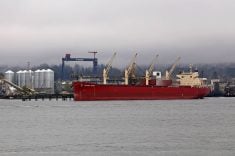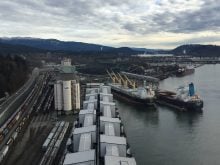Talks planned to resolve a bottleneck in the supply chain that can leave trains stranded when it rains on the West Coast
One day this fall, there were nine grain trains stranded on the way to Vancouver, unable to unload their cargoes at port terminals.
Why? Because it had been raining. Most grain-loading in Vancouver is cancelled when it rains.
For all the talk about Canada developing a high-velocity, high-throughput grain transportation system, it can still be shut down by rain in Vancouver.
“It rains a lot in Vancouver,” noted Mark Hemmes, president of federal grain monitor Quorum Corp., during the University of Manitoba Transport Institute’s Fields on Wheels conference Dec. 15.
Read Also

Agritechnica Day 3: Hybrid drive for a combine, data standards keep up to tech change and tractors of the year
Agritechnica 2025 Day 3: Hybrid drive for a combine, data standards keep up to tech change and tractors of the year.
Indeed. On average, every other day in Vancouver is affected by rain, and when Vancouver is the main export channel for Canadian grain, that rain reality means idled loading, trains that can’t unload at plugged terminals, grain elevators in the country that can’t ship crops, and farmers unable to deliver grain.
It can also mean the best markets for Canadian grain can be lost. Demand is often hottest right after Canadian crops have been harvested because southern hemisphere crops are months away from market. If buyers must wait too long to get Canadian supplies, they might wait a while longer to get cheaper South American crops.
Transport Canada is soon holding talks with industry and others about how to improve the loading-grain-in-the-rain issue. The vexing situation has lingered for years, worsening in the late 2000s, but there is now federal pressure on ports to move ships in and out more quickly than has been allowed in the past.
That means ships shouldn’t just be parked for extended periods, waiting for the weather to get nicer. The entire grain industry would like to see that improved too.
“If grain can’t be unloaded at the port terminals because of rain, whether that’s full days or shifts lost, then hopper cars can’t be cycled back to the in-country elevators to be reloaded with grain, and those delays have cascading impacts on the entire supply chain,” said Canadian Pacific Railway assistant vice-president Elizabeth Hucker.
Rain is nothing new in Vancouver, nor are challenges loading grain while it rains. Ship captains don’t like loading in the rain because if the grain gets damp, it can heat and spoil during ocean voyages.
Existing methods of loading during the rain were stopped by labour dispute arbitrations that set new rules in 2007. To ensure that longshore workers were safe while loading grain during wet conditions, terminal operators agreed to have workers install rails and shielding around holds.
That, however, takes three to four hours to set up, and the same to dismantle, each time it’s done. That often means terminals won’t attempt to load in the rain.
“It’s better than nothing, but not much better than nothing,” said Wade Sobkowich, executive director of the Western Grain Elevator Association.
“They (tend to avoid loading grain) until they have a window when there’s no precipitation and then load as much as they can.”
With rain affecting 46 percent of the days in Vancouver, this is an impediment.
“It’s not practical,” said Sobkowich about the choice between onerous safety procedures and not loading at all.
“We need a practical solution.”
















